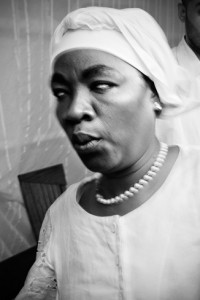In class, we briefly touched on the beginnings of spiritualist photography. The contemporary photographer Shannon Taggart has photographed the world’s largest Spiritualist community in western New York. Her photographic projects often focus on alternative types of religious experience. Taggart’s recent work is based on the Haitian practice of Vodou right here in Brooklyn. Read about and look at Taggart’s Vodou photographs at the Time Magazine Lightbox website.
You can further explore Taggart’s Vodou series and her other photographs on her personal website: www.shannontaggart.com.
We will discuss the difficulty of producing religious imagery via photography (for example, look at F. Holland Day). For this post, I would like you to consider the difficulties of documenting religious experience. Do you think such documentation possible? valuable? intrusive?
Please share your thoughts with your classmates by Saturday, March 16th.





I find Taggart’s photography and a backstory to what is going on very interesting and refreshing. There is always a lot of negative talk towards Voudou. People don’t understand what it is nor care to educate themselves. As outrageous as Voudou sounds to many of us, it is a practice that many people do and it is not all that of what we see for face value. The expressions of all these people are all erratic. It shows that they have been taken over by spirits and at that present time, they don’t belong to themselves. Viewers of these photos may argue that these photos are staged simply because they don’t believe in spirits and ghosts. There is no actual proof that these people are possessed except for the photos. Nobody really knows what was going on while these photos were taken. It is possible to document Voudou but the question rises about it being true. This kind of documentation can be valuable and beneficial with the small article that comes with it. If Taggart just released these pictures with no story about where she went and what goes on the photos would not have been valuable. They would just frighten the people looking at the pictures. With an explanation and clarification of what goes on during these rituals, people can understand more and are less likely to be critical. Though it is good that Taggart photographed and documented the Voudou culture in Brooklyn, any outsider coming into someone else’s place of ritual is intrusive. This is a private place where people go to practice their religion, Taggart photographing them possessed is intrusive and violates privacy but she does it with good reason.
Im always intrigued when I read into a subject I’m not too familiar with. Vodou is always a controversial topic to discuss. Many do feel like it’s a negative form of communication toward the afterlife. I do feel like before judging anything one should educate themselves on the topic at hand. Taggart’s project to me is very interesting, and daring. I admire her detemination to want to capture the images of priests and laymen undergoing possession by the Loa it could be a dangerous factor to be in the crossfire of such event. But without individuals such as Taggart viewers wouldn’t be able to see the emotions and the reactions takeing place during the possessions. I do believe taking these images is valuble because I believe that everything has a meaning behind it without a doubt. Especially something so controversal and not believable topis such as vodou. Referring to Taggart’s project I don’t believe she’s intruding with this particular project because the priest and laymen are completely aware that she is photographing them during their vulnerable stage. Any other moment where the photographer were to capture photos of an individual and a vulnerable stage without their consent I would agree that it’s intrusive, but not when it comes to taggart.